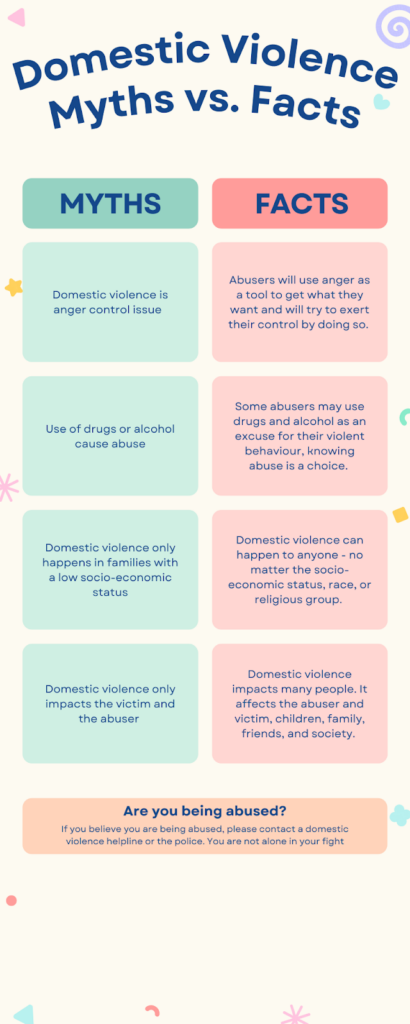
By: Anusha Khurram
Domestic abuse or “intimate partner violence” is typically defined as a pattern of behaviour used to gain or maintain power and control over an intimate partner (Nations). This type of abuse can be physical, emotional, sexual, economic, or psychological. Domestic abuse affects those in minority groups and has long-term and short-term effects on a person’s mental and physical health. More often than not, survivors have fear about coming forward about their experiences. There are many assumptions and stereotypes surrounding domestic violence. Still, the critical thing to remember is that anyone can be a victim, as this type of abuse manifests as a way to exert control over the victim.
Myths vs. Facts
There are many misconceptions surrounding domestic violence, and oftentimes those being abused fail to recognize what is actually happening to them. Abusers may also make excuses for their behaviour, such as drugs, alcohol, or anger issues, and try to cloud their victim’s judgement as a means of exerting control over them. The impact does not stop here either. While an abuser could lead the victim to believe the experience is between the two of them, in reality, domestic violence affects the abuser and victim, as well as children, family, friends, and society.
Additionally, a common misconception to many individuals is that domestic abuse only occurs in families with low socio-economic status. This is undoubtedly false as we have clear evidence that domestic violence can happen to anyone – irrespective of socio-economic status, race, or religious group.
Below you’ll find some myths and facts that may help you better clarify the severity of domestic abuse.

The more time spent in an abusive relationship, the greater toll it will take on the victim. Many victims tend to blame themselves in this situation as abusers may make them feel deserving of it. However, it’s important to note that the abuse is never the fault of the victim.
Break the Cycle
Abuse can oftentimes occur in cycles. This typically happens when a power imbalance remains in a relationship. It means that one person still exerts control over another person. Even though abuse can occur without warning, there are sure signs that can suggest the possibility of abuse. If you are in an abusive situation, there is a vicious cycle that you may be familiar with:
• Your abuser threatens violence
• Your abuser strikes
• Your abuser apologizes, promises to change, and offers gifts
• The cycle repeats itself
Where to Find Help
It can be challenging to seek help. Many survivors do not come forward and disclose their abuse out of fear. Many resources are available if you look online, and there are people in your life willing to help. Sometimes, you need to take the first step to get help in any way that fits you. If you are experiencing an immediate emergency, call 911 or your local authorities. However, the following resources may also prove helpful:
• Someone you trust. Turning to a friend, loved one, neighbour, or spiritual advisor for support may help get your story out there. Telling someone you trust may come easier than telling authorities or a stranger.
• Domestic Violence Hotline. Call a helpline for crisis intervention and referrals to resources.
• Your health care provider. A health care provider can treat injuries and refer you to safe housing or other local resources.
• A local women’s shelter or crisis center. Use ShelterSafe to find shelters and support services in your area.
• A counselling or mental health center. There are counselling options and support groups for women in abusive relationships. These are available in most communities.
• A local court. A court can help you obtain restraining instructions that legally command the abuser to stay away from you. Local advocates may be available to help guide you through the process.
It can be hard to identify that you need help getting out of an abusive situation, but you are never alone. Domestic violence includes the abuser forcing power and control over the victim. Understanding and identifying the truths and signs of domestic abuse can be the first step in breaking free from the cycle of abuse. There are many things related to domestic violence that people get mixed up. By developing a proper understanding of domestic abuse, you can better get yourself out of an abusive situation and help your loved ones leave similar problems as well.




